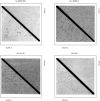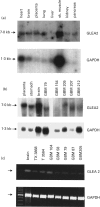Glioma-expressed antigen 2 (GLEA2): a novel protein that can elicit immune responses in glioblastoma patients and some controls
- PMID: 11703362
- PMCID: PMC1906187
- DOI: 10.1046/j.1365-2249.2001.01635.x
Glioma-expressed antigen 2 (GLEA2): a novel protein that can elicit immune responses in glioblastoma patients and some controls
Abstract
Glioma constitutes the most frequent brain tumour in man with glioblastoma as the most prevalent and malignant type. The average survival time of less than 16 months underlines the need for improvements in diagnosis and therapy. Here, we report the identification of a novel antigen termed glioma-expressed antigen 2 (GLEA2) causing a frequent immune response in glioma patients. Screening of 450 000 clones from a glioblastoma lambda zap expression library with autologous patient serum revealed a group of five serum-positive clones sharing a high sequence homology. Further sequence analysis showed a sequence homology to a hepatocellular carcinoma associated antigen 58 (HCA58). We localized the novel HCA homologous gene termed glioma-expressed antigen 2 (GLEA2) on chromosome 20 by somatic cell hybrid panel mapping. Using allogenic sera from 39 glioblastoma patients, we found an immune response against GLEA2 in 17 patients (43%). In addition, screening with allogenic sera from other glioma patients revealed GLEA2 directed antibodies in two out of five pilocytic astrocytomas and in one out of two astrocytomas. Unrelated tumour sera revealed no immune response and sera from healthy persons showed an immune response in two out of 14 cases (14%). Northern blot hybridization and RT-PCR showed ubiquitous GLEA2 gene expression in glioma and normal tissues. The novel HCA homologous gene, GLEA2, appears to induce a frequent immune response in glioma. In the light of the lack of useful glioma markers, it appears reasonable to consider GLEA2 as a potential future diagnostic marker.
Figures





Similar articles
-
Autoantibodies against GLEA2 and PHF3 in glioblastoma: tumor-associated autoantibodies correlated with prolonged survival.Int J Cancer. 2005 Nov 10;117(3):456-9. doi: 10.1002/ijc.20929. Int J Cancer. 2005. PMID: 15906353
-
High expression and frequently humoral immune response of melanoma-associated antigen D4 in glioma.Int J Clin Exp Pathol. 2014 Apr 15;7(5):2350-60. eCollection 2014. Int J Clin Exp Pathol. 2014. PMID: 24966945 Free PMC article.
-
Novel tumor antigens identified by autologous antibody screening of childhood medulloblastoma cDNA libraries.Int J Cancer. 2003 Aug 20;106(2):244-51. doi: 10.1002/ijc.11208. Int J Cancer. 2003. PMID: 12800201
-
Immunological considerations and the malignant glioma problem.Clin Neurosurg. 1968;15:175-89. doi: 10.1093/neurosurgery/15.cn_suppl_1.175. Clin Neurosurg. 1968. PMID: 4333303 Review. No abstract available.
-
Microglia/Brain Macrophages as Central Drivers of Brain Tumor Pathobiology.Neuron. 2019 Nov 6;104(3):442-449. doi: 10.1016/j.neuron.2019.08.028. Neuron. 2019. PMID: 31697921 Free PMC article. Review.
Cited by
-
Increased seroreactivity to glioma-expressed antigen 2 in brain tumor patients under radiation.PLoS One. 2008 May 14;3(5):e2164. doi: 10.1371/journal.pone.0002164. PLoS One. 2008. PMID: 18478111 Free PMC article.
-
Dendritic cells transduced with glioma-expressed antigen 2 recombinant adenovirus induces specific cytotoxic lymphocyte response and anti-tumor effect in mice.J Inflamm (Lond). 2020 Jan 31;17:3. doi: 10.1186/s12950-020-0239-6. eCollection 2020. J Inflamm (Lond). 2020. PMID: 32021567 Free PMC article.
-
PHF20 is an effector protein of p53 double lysine methylation that stabilizes and activates p53.Nat Struct Mol Biol. 2012 Sep;19(9):916-24. doi: 10.1038/nsmb.2353. Epub 2012 Aug 5. Nat Struct Mol Biol. 2012. PMID: 22864287 Free PMC article.
-
Identification of genes and pathways potentially related to PHF20 by gene expression profile analysis of glioblastoma U87 cell line.Cancer Cell Int. 2017 Oct 4;17:87. doi: 10.1186/s12935-017-0459-x. eCollection 2017. Cancer Cell Int. 2017. PMID: 29033691 Free PMC article.
-
Personalized mRNA vaccines in glioblastoma therapy: from rational design to clinical trials.J Nanobiotechnology. 2024 Oct 4;22(1):601. doi: 10.1186/s12951-024-02882-x. J Nanobiotechnology. 2024. PMID: 39367418 Free PMC article. Review.
References
-
- Prados MD, Gutin PH, Philips TL, et al. Highly anaplastic astrocytoma: a review of 357 patients treated between 1977 and 1989. Int J Radiat Oncol Biol Phys. 1992;23:3–8. - PubMed
-
- Lang FF, Miller DC, Koslow M, Newcomb EW. Pathways leading to glioblastoma multiforme: a molecular analysis of genetic alterations in 65 astrocytic tumors. J Neurosurg. 1994;81:427–36. - PubMed
-
- Frankel RH, Bayona W, Koslow M, Newcomb EW. p53 mutations in human malignant gliomas. Comparison of loss of heterozygosity with mutation frequency. Cancer Res. 1992;52:1427–33. - PubMed
-
- Fults D, Brockmeyer D, Tullous MW, Podone CA, Cawthon RM. p53 mutation and loss of heterozygosity on chromosomes 17 and 10 during human astrocytoma progression. Cancer Res. 1992;52:674–79. - PubMed
Publication types
MeSH terms
Substances
LinkOut - more resources
Full Text Sources
Other Literature Sources
Medical
Molecular Biology Databases

